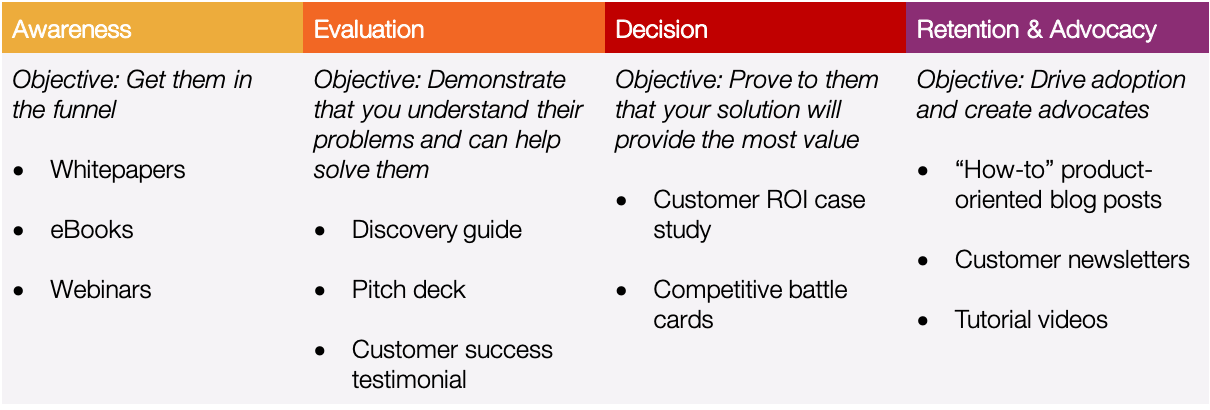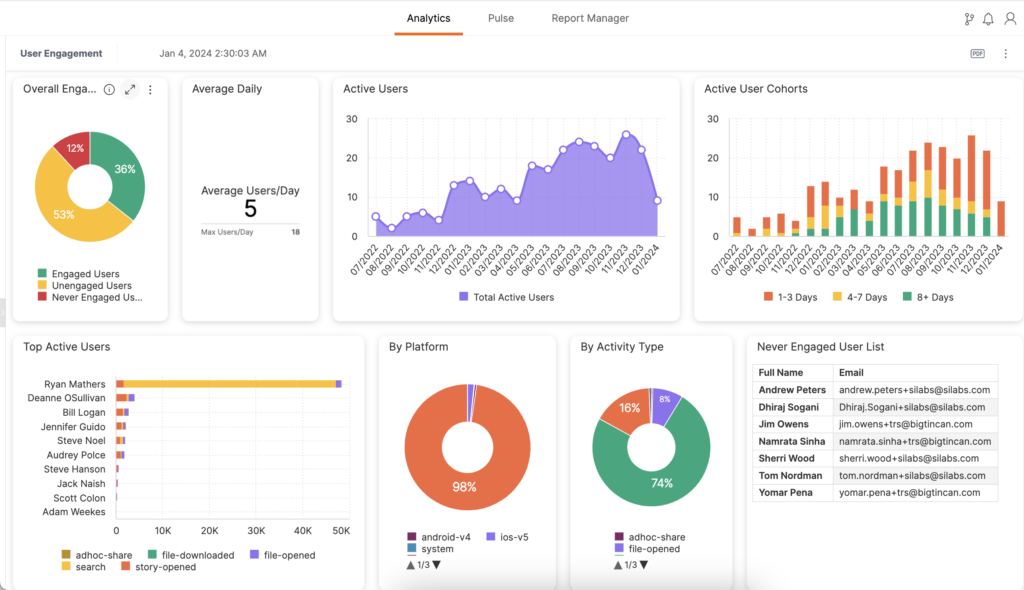Today’s buyers expect personalized everything. Their streaming apps know what they’ll binge next. Their maps recommend dinner spots before they’re even hungry. So no, they don’t want another sales deck full of generic messaging.
If you want to win their trust, you need to prove you understand their world. That means ditching the one-size-fits-all approach and building sales content that actually solves their problems.
In this article, you’ll learn how to use AI, analytics and real-world workflows to deliver the right message at the right moment. And we’ll show you how Bigtincan makes it all easier with a single, unified platform.
Step 1: Segment your audience strategically
Let’s say you’re targeting a healthcare IT director at a mid-sized clinic. Their priorities (compliance, ease of implementation, vendor reliability) are going to be totally different from a retail CIO at a global enterprise, who’s focused on scalability, integrations, and omnichannel experience. If you send them both the same generic pitch deck, you’ve already lost.
So, start the process by defining your buyer personas — not just “IT Director” or “HR Manager,” but what size company they work for, what problems keep them up at night, and how they make decisions. The more specific you get, the easier it becomes to tailor content that actually resonates.
What to do:
- Identify all the different segments that you may want to direct content towards. These could be defined by:
- Role or profile: Do you want to connect with C-suite executives, IT or Finance teams, end users?
- Industry or vertical: What are the different sectors in your target audience?
- Company size or status: Do you deal with start-ups, SMBs, or large established enterprises?
- Funnel stage: Do you want to attract new prospects, as well as nurturing and converting the ones you have?
- Don’t try to boil the ocean. Prioritize your most commonly encountered audience. Recent data trends from your CRM can help here. Or you could survey your sellers about what they think is the most immediate need.
- Define each target audience’s problems. Survey your salespeople and customers to understand the main pain points. Here are some customer questions to guide your discovery:
- What is your role and what are your top priorities?
- What are your biggest challenges?
- What content or resources help you make decisions?
- What would life be like with a solution like ours?
- Use our messaging template to develop a messaging framework that will guide sales content creation for each segment and keep messaging consistent.
- Specify the content types that suit each segment as they move through the buyer journey. Here are some examples of useful content for each stage:

Pro tip: With a platform like Bigtincan Content, you can take the guesswork out of personalization. It uses CRM data, interaction history, and browsing behavior to automatically categorize buyers and suggest the most relevant content, like a case study on HIPAA compliance for one, and a retail deployment roadmap for the other. Sellers spend less time searching, and buyers get content that actually feels like it was made for them.
Step 2: Use AI to create personalized content
Creating personalized content for every buyer type sounds like a slog. But it doesn’t have to be. With a sales content platform like Bigtincan, you can repurpose what you already have and use AI to fill the gaps quickly.
For example, if you need a version of your pitch for a manufacturing CFO, Bigtincan can create one that highlights cost savings, streamlines the messaging, and updates examples automatically.
Bigtincan was really able to help us customize and get to the solution that provided the best experience for our dealer network and our customers.
Dominick Beckman, Director of Marketing & Dealer Operations, Hino Trucks. See the full case study.
Step 3: Automatically surface content for your sales reps
Once you have created sales content for your different audiences, you need to ensure your sellers can find the right material for each sales opportunity. That’s where a sales content platform makes all the difference.
Instead of hunting through shared folders or Slack threads, reps get fast access to the right content for each sales moment.
- Tags make it easy to filter by persona, industry, product line, or sales stage.
- AI-powered search lets reps enter just a few details, like the buyer’s role or company size, and get back a curated list of content.
- Smart recommendations surface the most effective content for similar deals, based on usage and outcomes.
- Digital Sales Rooms allow reps to share all relevant content in one link, personalized for each buyer.
- Version control, so that when Product or Legal updates a slide, it syncs across every template automatically.
- Engagement tracking shows which content buyers actually view or share, so reps can follow up more strategically.
Picture a rep preparing for a call with an enterprise IT lead in healthcare. A tool like Bigtincan’s Genie AI will pull up a relevant case study, a compliance-focused product sheet, and a short intro deck, all ready to go.
You can also see which content gets used and what actually resonates with buyers. That feedback loop helps marketing improve future content and helps enablement teams coach reps on what to use, when.
What to do:
- Choose a sales content management solution that meets your needs. We’ve put together a handy comparison guide to help you make your decision.
- Use templates and AI-powered authoring tools to create personalized content for each of your segments.
- Use tags and collections to organize your content by audience segment and by sales cycle stage, so your reps can find the content they need.
- Train your revenue team on getting the most out of your sales content management solution, from finding the right assets to sharing content in Digital Sales Rooms.
- Build a content audit workflow. Regularly review what’s being used, what’s outdated, and where the gaps are.
- Set up performance tracking. Use engagement analytics to understand which content is moving deals forward and which assets need improvement.
- Create a feedback loop between marketing, enablement, and sales. Encourage reps to flag content they need or suggest edits based on live conversations.
- Highlight wins. When a rep closes a deal using a specific deck or one-pager, share the story and build internal visibility for what good looks like.
- Make it easy to update. Use version control and standardized templates to keep content fresh and compliant without creating bottlenecks.
Step 3: Enable more granular personalization
Even segmented content can fall flat if it still feels generic. Buyers can tell when something was created “for someone like them” versus created for them.
When reps tailor content to reflect a buyer’s actual priorities, it builds credibility and shows they’re paying attention. That might mean combining the right materials, adjusting the messaging, and adding personalized touches like the customer’s name or logo.
A sales content platform like Bigtincan makes that level of customization doable at scale:
- Content assembly: Pull together multiple assets — videos, slides, PDFs, webpages — into one seamless presentation without leaving the platform.
- Slide reordering and hiding: Move slides and pages around or hide irrelevant content to customize a deck for that customers’ needs.
- Text and image editing: Add editable text and image fields for personalized touches like the company name or logo.
- Document automation: Templates and live CRM data make it easy to generate customized documents.
- Personalized microsites: Reps can build digital sales rooms with links to relevant content for buyers to browse as they wish.
What to do:
- Train sellers to use the personalization features of your sales content management solution.
- Use customizable text and image fields to:
- Add sellers’ names, titles, and contact information.
- Include a “What we heard from you” slide, to demonstrate how you are shaping your solution to your buyers’ needs.
- Insert client logos, company information and relevant use cases so that content resonates with the prospect.
- Create reusable templates for common deal types, but leave space for customization so sellers aren’t starting from scratch.
Step 4: Use engagement insights to guide next steps

Say you send a deck to a buyer — do you know if they opened it? Skipped half the slides? Shared it with their CFO?
Personalized content is only useful if you know how it’s performing. Otherwise, you're just guessing. To get better, you need real insight into what different segments care about and what’s actually moving deals forward. That’s where Bigtincan’s dynamic analytics can help, giving your team clear data on what buyers are engaging with, and what’s getting ignored.
For example, you might find that enterprise buyers in healthcare spend more time with analyst reports and skip video, while mid-market tech buyers engage most with short slide decks and case studies. That kind of insight helps you prioritize content creation.
What to do:
- Establish baseline metrics: content usage rate, engagement time, sharing statistics and impact on revenue. These will help you track how your sales content strategy is performing and improving.
- Monitor which content types (case studies, ebooks, whitepapers, analyst reports), topics, and formats (presentations, PDFs, videos) perform best for each segment.
- Look for trends in engagement to determine where to focus sales content creation efforts next.
- Address any gaps in content usage and engagement. If one persona is barely engaging with the available content, that’s a sign they may need more targeted resources.
- Review your metrics regularly. Revisit your baseline KPIs every quarter to measure the impact of your sales content strategy.
- Ensure sellers are using engagement insights to personalize buyer interactions by:
- Responding to open notifications for shared content.
- Monitoring granular engagement insights (e.g., which slides generated high engagement) to understand buyers’ interests and tailor the next steps in the deal around that.
Perfect your personalized sales content creation with Bigtincan
What if every seller could walk into a meeting fully prepped, with personalized, on-brand content they didn’t have to build from scratch?
What if you could finally see which content moves deals forward, and cut the rest?
Bigtincan gives you the tools to make that happen.
From AI-powered content creation to smart analytics and seamless CRM integration, it's everything you need to personalize at scale — and close faster.
Bigtincan includes:
- AuthoringAI to up your productivity with AI-driven drafts, accurate voiceovers and captioning, and multi-language translations.
- Genie Assistant to get tailored suggestions and actions, within personalized digital sales rooms.
- RolePlayAI so your sales reps practice and refine their skills for each customer.
- Sales AI, to automate content recommendations for the buyer at each stage of the customer journey.
- Intuitive dashboards to track content usage and engagement, sales performance, and support data-driven decision-making.
- Integration with CRM systems like Salesforce and Microsoft Dynamics.
With Bigtincan, your salespeople can channel AI-powered content creation recommendations and analytics to make sure each customer gets the specialized sales service they deserve.
Book a demo to see how Bigtincan can help you deliver the right message, to the right buyer, every time.
